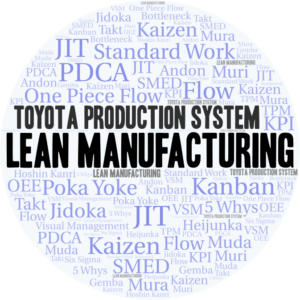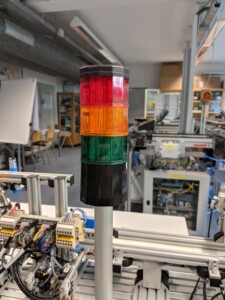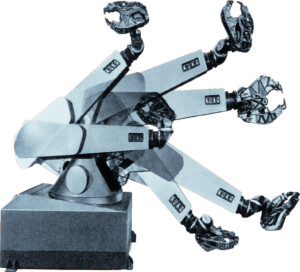 Pull systems like kanban and reorder point are a cornerstone of inventory management and fluctuation reduction in lean manufacturing. The production is managed based on ACTUAL consumption. Theoretically, it is also possible to include expected but not yet actual consumption. In this post, I will explain to you the concept behind it and why I think it is a bad idea…
Pull systems like kanban and reorder point are a cornerstone of inventory management and fluctuation reduction in lean manufacturing. The production is managed based on ACTUAL consumption. Theoretically, it is also possible to include expected but not yet actual consumption. In this post, I will explain to you the concept behind it and why I think it is a bad idea…
Christoph Roser
The Difference between the Toyota Production System and Lean Manufacturing
 The Toyota Production System (TPS) is the archetype of lean manufacturing. Lean is often used as a synonym for the Toyota Production System, and that is generally quite accurate. It is also sometimes referred to as the “Westernized” version of the Toyota Production System. However, there are some smaller differences in the underlying approach, as well as some larger and often unintentional differences in its application. Let’s have a look!
The Toyota Production System (TPS) is the archetype of lean manufacturing. Lean is often used as a synonym for the Toyota Production System, and that is generally quite accurate. It is also sometimes referred to as the “Westernized” version of the Toyota Production System. However, there are some smaller differences in the underlying approach, as well as some larger and often unintentional differences in its application. Let’s have a look!
KUKA FAMULUS Turns 50—The First Modern Industrial Robot
When to Use a Milk Run
 A milk run is a popular way to supply materials to multiple locations. It can easily be combined with a pull system like kanban, where it merely replenishes what was consumed. But what are the best uses for milk runs? And when do you use them, and when would another logistics system be better? This post points out where the milk run shines and where you should consider alternatives.
A milk run is a popular way to supply materials to multiple locations. It can easily be combined with a pull system like kanban, where it merely replenishes what was consumed. But what are the best uses for milk runs? And when do you use them, and when would another logistics system be better? This post points out where the milk run shines and where you should consider alternatives.
Stack Lights—Visual Management Done Easy
 Stack lights are found everywhere in industry. And for a good reason. They are a quick and easy way to visualize the status of a machine, which otherwise would need some effort to see. They are—sort of—a mini-andon. While sometimes underappreciated, they do serve a valuable purpose in the factory, and they usually do a good job. Let’s have a look at stack lights!
Stack lights are found everywhere in industry. And for a good reason. They are a quick and easy way to visualize the status of a machine, which otherwise would need some effort to see. They are—sort of—a mini-andon. While sometimes underappreciated, they do serve a valuable purpose in the factory, and they usually do a good job. Let’s have a look at stack lights!
SMED 2.0—A Changeover for the Changeover
 Single Minute Exchange of Die (SMED) to reduce and shorten changeover times is one of the best-known methods in lean manufacturing. However, the original steps as shown by Shingo have, in my view, potential for improvement. Hence, I restructured the changeover workshop based on my experience with SMED to make it easier and more straightforward. This rework is not groundbreaking or revolutionary, but merely a few small changes to make it easier to use. As it is popular nowadays, I also added a 2.0 after SMED for my SMED 2.0.
Single Minute Exchange of Die (SMED) to reduce and shorten changeover times is one of the best-known methods in lean manufacturing. However, the original steps as shown by Shingo have, in my view, potential for improvement. Hence, I restructured the changeover workshop based on my experience with SMED to make it easier and more straightforward. This rework is not groundbreaking or revolutionary, but merely a few small changes to make it easier to use. As it is popular nowadays, I also added a 2.0 after SMED for my SMED 2.0.
The Danger of Management by Numbers
 One of the main hindrances for proper lean manufacturing is, in my view, management by numbers. While few managers actively do management by numbers, a quantitative measurement is still often preferred. The problem is if you can measure the cost but not the benefits of something…which often happens in lean manufacturing. Now let me rant a bit…
One of the main hindrances for proper lean manufacturing is, in my view, management by numbers. While few managers actively do management by numbers, a quantitative measurement is still often preferred. The problem is if you can measure the cost but not the benefits of something…which often happens in lean manufacturing. Now let me rant a bit…
Making the Problem go Away Is NOT Improvement
Managing problems  is an important part of manufacturing because it allows companies to identify and address issues that can impact product quality, production efficiency, and overall profitability. However, it is not to be confused with actual improvement. While taking care of the problem (hopefully) makes the problem go away, actual kaizen requires that the problem should not come back.
is an important part of manufacturing because it allows companies to identify and address issues that can impact product quality, production efficiency, and overall profitability. However, it is not to be confused with actual improvement. While taking care of the problem (hopefully) makes the problem go away, actual kaizen requires that the problem should not come back.

